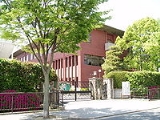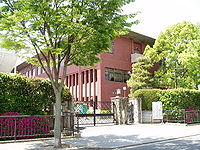
Kyoto Prefectural University
Encyclopedia

Japan
Japan is an island nation in East Asia. Located in the Pacific Ocean, it lies to the east of the Sea of Japan, China, North Korea, South Korea and Russia, stretching from the Sea of Okhotsk in the north to the East China Sea and Taiwan in the south...
. Its campus is located in Nakaragi-cho, Shimogamo, Sakyo-ku
Sakyo-ku, Kyoto
is one of the eleven wards in the city of Kyoto, in Kyoto Prefecture, Japan. It was created in 1929 when it was split off from Kamigyo-ku.It is located in the north-east corner of Kyoto city. In the east it borders the city of Ōtsu in Shiga Prefecture. In the south Sanjō Street separates it from...
, Kyoto
Kyoto
is a city in the central part of the island of Honshū, Japan. It has a population close to 1.5 million. Formerly the imperial capital of Japan, it is now the capital of Kyoto Prefecture, as well as a major part of the Osaka-Kobe-Kyoto metropolitan area.-History:...
.
History
Kyoto Prefectural University was established in 1949 as by mingling two prefectural colleges: Kyoto Prefectural Agricultural and Forestry Vocational School (京都府立農林専門学校 Kyōto furitsu nōrin semmon gakkō, founded in 1895) and Kyoto Prefectural Women's Vocational School (京都府立女子専門学校 Kyōto furitsu joshi semmon gakkō, founded in 1927).Saikyo University had at first two faculties: the Faculty of Letters and Domestic Science (in Katsura Campus) / the Faculty of Agriculture (in Shimogamo Campus). The brief history of the university is as follows:
- 1951: The Faculty of Women's Junior College was established (in Katsura Campus).
- 1959: The University was renamed Kyoto Prefectural University.
- 1962: All the faculties were integrated in Shimogamo Campus (Katsura Campus was abolished).
- 1970: The Faculty of Letters and Domestic Science was reorganized into two faculties.
- The Graduate School of Agriculture was established (Master's courses).
- 1977: The Faculty of Domestic Science was renamed Faculty of Living Science.
- 1983: A Doctoral course was added to the Graduate School of Agriculture.
- 1986: The Graduate School of Living Science was established (Master's courses).
- 1990: The Graduate School of Letters was established (Master's courses).
- 1997: The Faculty of Living Science was reorganized into two faculties: the Faculty of Welfare Society and the Faculty of Human Environment.
- 1998: The Faculty of Women's Junior College was abolished.
- 2001: Doctoral courses were added to the Graduate School of Letters.
- The Graduate School of Welfare Society was established.
- The Graduate School of Living Science was renamed Graduate School of Human Environment Science (with Doctoral courses).
- 2008: The faculties and graduate schools were reorganized.
Undergraduate Schools
- Faculty of Letters
- Faculty of Welfare Society
- Faculty of Human Environment
- Faculty of Agriculture
The faculties above were reorganized into three new faculties (in April 2008):
- Faculty of Letters
- Faculty of Public Policy
- Faculty of Life and Environmental Sciences
Graduate Schools
- Graduate School of Letters
- Graduate School of Welfare Society
- Graduate School of Human Environment Science
- Graduate School of Agriculture
The graduate schools above were reorganized into three new schools (in April 2008):
- Graduate School of Letters
- Graduate School of Public Policy
- Graduate School of Life and Environmental Sciences
External links
- Official Website (Japanese)

